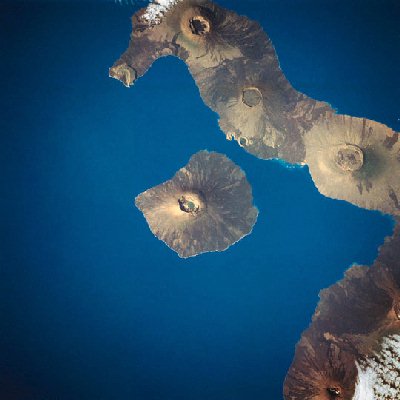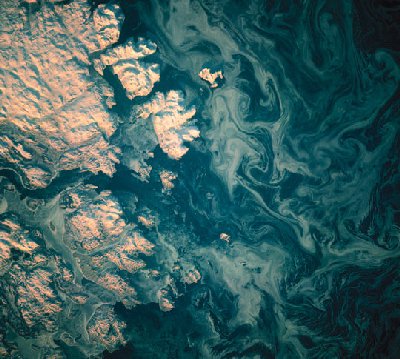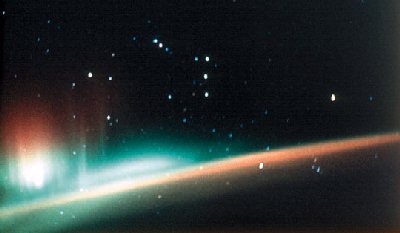 |

Film cannot capture the experience of watching the planet at night. After dinner, we often darken the ship and glide across moonlit continents. On the second evening of the flight, we float in the forward windows, watching Africa with her clouds clearly outlined by moonlight, seeing lightning and the lights of cities passing below. The Magellanic clouds and the southern Milky Way are clear, and the windows are filled with stars. We can see perhaps 150 degrees of the Earth’s horizon through our enormous windows. The atmosphere appears to be much thicker by night than by day, and well above it we can see the tenuous yellow haze of the airglow layer. Looking again through the great sweep of our windows at the city lights through thin ground fog, we imagine ourselves to be in the gondola of a giant balloon floating without vibration across the continent.
When sunrise comes, we can see at least eight layers of blue in the
atmosphere, illuminated like stained glass. Each layer has its own brilliant
shade of blue, and is separated from the next by a distinct line not captured
in any photograph. The geometry is stunning: the giant planet beneath us
is wrapped in a very thin atmosphere indeed. We know the history of the
moon, Mars, and Venus, and wonder at the combination of forces that has
left Earth with this gossamer pressure vessel of exquisite design and unknown
duration.
 |
Outside the cabin, on two spacewalks, I saw a wonderful effect. Just as the full moon appears to be much larger when viewed near the horizon (because of the proximity of trees and houses to act as size references), features on the Earth appear much larger when viewed close to the edge of the orbiter’s cargo bay. My partner and I saw the Namib desert in this way near sunset, and the sand sea’s red dunes seemed enormous and close. This effect also gave us the strongest sense of speed we felt on orbit, when we passed over Central America during the second spacewalk. It was close to the port wing, and we felt as if we were rushing at incredible speed past Lake Managua, Lake Nicaragua, the Panama canal, and into the bulk of South America. Leaning back to allow the Earth to fill the suit’s faceplate gave me a feel for how large this planet really is. The land is only a tiny fraction of our world, and the oceans between continents seem enormous. Yet we bridge them daily in airliners as we drink our coffee, thinking the planet is small because we look out the window only infrequently.
I have talked to many groups throughout the United States and the world about the Earth, and have found that several topics are consistently interesting to people. We want to know what the world looks like now, what forces are shaping it, and what it has looked like in the past and may look like in the future. We want to know about how life arose here, and how it changed so rapidly from simple forms such as algae to all the complex life forms we now see (and the many more that have died out along the way). We want to understand not only evolution of life, but of the Earth as well, and so want to learn about ecology and global environmental change.
My transition from NASA to Carnegie Museum of Natural History is an
enlargement of the sharing of this view of Earth from a small audience
to a much larger one. I want to bring the magic of viewing our planet through
space and time to the visitors here at the museum.
 |
The research side of the Museum of Natural History encompasses 23 Ph.D. scientists and their support staff, and is now headed by Dean of Science Dr. Bradley C. Livezey. Our goals for the research staff are to encourage significant contributions to both science and to the public side of the museum. Scientific positions will be filled on the basis of national reputations, and staff will be evaluated for promotion and retention based on effectiveness of their scientific research. As in a university, outside visiting committees will periodically evaluate our programs and provide advice to the dean and director. In a university, scientists are expected to share their knowledge through teaching. In our museum, there is now an explicit requirement for scientists to contribute to the public side of the museum by helping to bring the excitement of science to this museum of the Earth.
Our plans for the museum are based on a strategic plan developed over
the past year, with the active participation of the Board of Trustees and
the museum staff. We have held focus groups to survey public attitudes
towards our museum, and towards its new strategy. In the next few years,
the Carnegie Museum of Natural History will become an interactive hands-on
place where our visitors can come to be excited about the Earth in new
ways with changing exhibits in a friendly atmosphere. We will show how
the Earth was formed and the twisted pathways through which complex life
evolved. We will talk about the issues that concern our visitors: ecology,
evolution, and climate change. All this will take several years, and the
dedicated help of our members.
Reading areas will be placed in Dinosaur Hall and in the new ALCOA Foundation Hall of American Indians (opening June 6) to permit in-depth study or just a place to relax in a friendly atmosphere while in the museum. Dinosaur Hall will also soon have yet another unique specimen: the first dinosaur ever to leave Earth. The skull of a 210-million-year-old Coelophysis was flown aboard the Shuttle Endeavour earlier this year on her voyage to the Russian Mir space station. Visitors can see a piece of space history here at the museum.
The largest creature ever to fly will come to the museum this year. Quetzalcoatlus northropi, a pterosaur (flying reptile) which lived at the same time as the dinosaurs had a wingspan of 35 feet, larger than some airplanes! Boeing Aircraft’s chief aerodynamicist will help us assemble the skeleton correctly, and we’ll be the first museum to have the huge carnivore on permanent display.
Three festivals will bring tremendous excitement to the museum.
The Carnegie Lectures on Global Environmental Change drew full-house crowds last fall, and the spring lectures (March 25th, April 13th, and May 19th at 7 pm in the Museum of Art Theater) are expected to be even more popular, with titles such as Costs and Benefits of Greenhouse Reduction and In a Democracy the Climate Problem is Whatever the Public Believes It Is.
Our museum is on a new journey, and the view is going to get even more
exciting in the years ahead, with your help. Climb aboard—Destination:
Earth!
 |
When Apt returned in 1991 from the first of his four space missions, he wanted to share the experience of looking at Earth from the space shuttle. With NASA’s permission, he and scientists Justin Wilkinson and Michael Helfert wrote a book showing some of the best photographs of the 268,000 taken by astronauts from orbit. The book, Orbit: NASA Astronauts Photograph the Earth, showcases the beauty and impact of the local and regional geology, land use, and ecology phenomena that can be seen from space. Orbit has appeared in 10 languages and is in its third printing in English. It is available at the Carnegie Museum of Natural History Store.
Copyright 1998 Carnegie Magazine All
rights reserved. Email: carnegiemag@carnegiemuseums.org
Highlights |
Calendar |
Back Issues |
Museums |